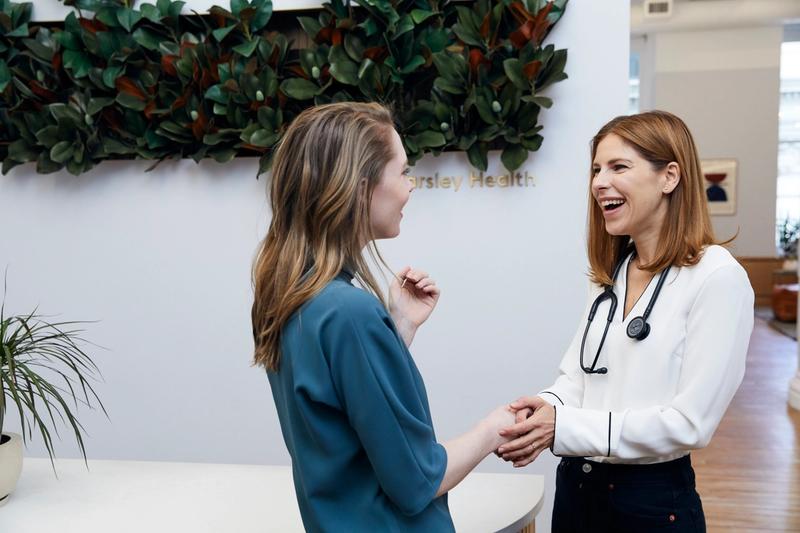The Healthy Aging Hack Parsley Doctors Swear By for Longevity

You might not spend much time thinking about your mitochondria, but they are one of the most important parts of your body. Read on for everything you need to know about improving your mitochondrial health.
What are the mitochondria and what do they do?
These tiny structures are present in every cell outside of red blood cells and have the extremely important job of producing energy. Thanks to your mitochondria, you can get through your workday, crush your workouts, and manage everyday tasks.
Technically, the mitochondria are organelles, or the “organs” that exist inside your cells and perform specific functions. For the mitochondria, this main function is converting blood glucose into a small molecule called adenosine triphosphate (ATP), which is known as the “energy currency” of the body because it’s a form of usable chemical energy that is needed to power each cell. If you think that sounds pretty important, it is! Without ATP, our cells wouldn’t be able to perform basic functions. According to Amy Coleman, MD, a family medicine physician formerly at Parsley, “They [the mitochondria] are silent, unsung heroes that are secretly making all of our energy.”
But that’s not all the mitochondria do, either. They are also responsible for storing calcium for cell signaling activities, generating heat, and mediating cell growth and death. Knowing this, it won’t surprise you to learn that research over the last few decades has uncovered a lot about the mitochondria and how they affect our health in ways we hadn’t imagined. For example, a 2019 study showed that the mitochondria set off molecular alarms when our cells are exposed to stress, chemical changes, or DNA damage; another study, published by the journal Nature, showed that healthy mitochondria can prevent the diseases caused by amyloid toxicity , like Alzheimer’s disease. Finally, a 2020 study revealed that a tiny peptide found in the genome of the mitochondria, called humanin, has a huge impact on health and longevity in both animals and humans.
In other words, healthy mitochondria are absolutely essential to healthy aging and our long term wellbeing.
What are the symptoms of low mitochondrial function?
Clearly, the mitochondria are a big deal. Unfortunately, mitochondrial health can suffer in more ways than one. According to Dr. Coleman there are two main types of mitochondrial issues. “There are mitochondrial diseases, which are much more severe and due problems in the DNA, and then there is mitochondrial dysfunction, which is the result of various lifestyle assaults on the mitochondria,” she explains. Most mitochondrial diseases are long-term, inherited disorders that only occur in about 1 in every 5,000 people , so for the purposes of this article, we’ll be focusing on mitochondrial dysfunction.
According to Dr. Coleman, some telltale symptoms that you may have low-functioning mitochondria include:
- Fatigue
- Sluggish thinking
- Memory loss
- Diminished endurance
- Low libido
- A depressed mental state
You may read the symptoms above and think they’re pretty vague and all over the place; well, that’s because the mitochondria are located in every nook and cranny of our body. As Dr. Coleman explains, “we have to realize that the mitochondria affects so many parts of bodies and health.” According to a 2014 paper, mitochondrial dysfunction can also be a contributing factor for other diseases. The author lists early aging, cardiovascular disease, chronic fatigue syndrome, diabetes, and even migraine headache as diseases that are either caused or aggravated by mitochondrial dysfunction . Numerous studies have also shown that mitochondria play a role in diseases of aging, like Parkinson’s disease , Alzheimer’s , retinal disease and even skin aging .
What causes mitochondrial dysfunction?
You may be wondering what causes the mitochondria to go from being in tip-top shape to being dysfunctional. As Dr. Coleman explains it: “Having chronic inflammation can put a lot of stress on the poor mitochondria.” Unfortunately, our modern lifestyles—with high-stress jobs, little time to relax and sleep , and environmental toxins—are a recipe for inflammation. Add that to the high-sugar, low-nutrient standard American diet, and “it leaves mitochondria without the nutrients—specifically the antioxidants—it needs to do its job,” Dr. Coleman continues. Another factor that puts our mitochondrial efficiency at risk is aging, which brings us to…
When should you start thinking about mitochondrial health?
As we age, our mitochondria start to function less efficiently. This is due to a decline in the activity of enzymes , a decrease in the capacity of each mitochondrion, and an increase in free radicals, according to a 2017 study. It’s also likely why mitochondria are implicated in many age-related diseases.
So, when do you need to start thinking about your mitochondrial health? According to Dr. Coleman, it’s not as simple as giving a number because there are two ages—your chronological age, which is the number of years since your birth, and your biological age, which is how quickly your body is really aging. “What I’ve found is that a lot of people have a much higher biological age than chronological age,” she says.
As a general rule, “if you can remember a time when you felt way better than you do now, that’s a good sign that it’s time to start tending to your mitochondria so you can rekindle that fountain of youth,” Dr. Coleman continues. In other words, if you’re dealing with fatigue, brain fog , a low mood, and a low sex drive and it can’t be directly attributed to another condition, it’s a good time to focus on your mitochondrial health. (It’s important to rule out other conditions first by working with a doctor who can evaluate you through advanced testing, like those at Parsley Health.)
How do you improve mitochondrial function?
The good news is that there are plenty of steps you can take to support your mitochondrial health and healthy aging, and all of these things can benefit other areas of your health, too. In fact, you may find you’re already taking steps to boost your mitochondria. According to Dr. Coleman, there are five great mitochondria-supporting lifestyle practices you can start incorporating into your routine today.
1. Antioxidants
“The standard American diet contains little-to-none of what the mitochondria need to thrive,” says Dr. Coleman. This is particularly true when it comes to antioxidants, which the mitochondria require to function optimally. Dr. Coleman recommends supplementing with resveratrol, which is the strongest antioxidant. “Another strong antioxidant is melatonin,” says Dr. Coleman. You might know melatonin as the “sleep hormone” but according to Dr. Coleman, “it’s actually one of the strongest antioxidants.” Parsley health providers work with members to determine the right supplement doses for them and will also help members to bolster their diet with antioxidant-rich foods.
2. Exercise
Exercise is another great practice for the mitochondrial health. For example, one study showed that high intensity exercise caused cells to make more proteins for the mitochondria, which helps stop aging at the cellular level. According to the researchers behind the study, this effect was particularly strong for aerobic exercises like biking and walking.
3. Sunlight
According to Dr. Coleman, “sunlight helps the mitochondria because it activates the cytochrome C, which helps to create ATP.” Cytochrome C is a type of protein located within mitochondria. She recommends getting at least 20-minutes of direct sunlight on your skin in the first half of the day, every day. The good news is that this will also help optimize your vitamin D levels , and spending time outdoors can benefit your overall health.
4. Intermittent fasting
“The mitochondria repopulate in times of fasting, so intermittent fasting is a great way to give these organelles a boost,” says Dr. Coleman. There are a lot of different ways to fast, but leaving a 14 to 16-hour window between dinner and breakfast the next day is a great place to start.
5. Cold therapy
Studies have shown that cold exposure, such as taking an ice bath, can boost mitochondrial function. For example, one study showed that postexercise cold water submersion enhanced mitochondrial biogenesis in skeletal muscle, or, it increased the mass of the mitochondria.
The mitochondria are the quiet, unsung heroes of our health and can always benefit from some extra attention. By incorporating some of the steps above, you can thank your mitochondria for all they do and contribute to healthy aging.
Ready to live a longer, healthier life? Start by taking the Parsley Health Index quiz to get your symptom score.
Correction: A previous version stated mitochondria are found in all cells. They are not found in red blood cells.
Gretchen Lidicker is a writer, researcher, and author of the book CBD Oil Everyday Secrets: A Lifestyle Guide To Hemp-Derived Health & Wellness. She has a masters degree in physiology and complementary and alternative medicine from Georgetown University and is the former health editor at mindbodygreen. She's been featured in the New York Times, Marie Claire, Forbes, SELF, The Times, Huffington Post, and Travel + Leisure.
Get a snapshot of your health - right now.
Take our quiz to get your symptom score and start uncovering the why behind your symptoms.
WHAT IS PARSLEY HEALTH?
Our leading medical providers and health coaches heal the root cause of health concerns with a personalized care plan and year-round support. Our root-cause resolution medicine has helped thousands feel better, with 85% of members reducing symptoms in their first year.

